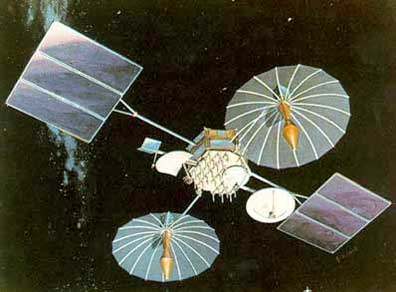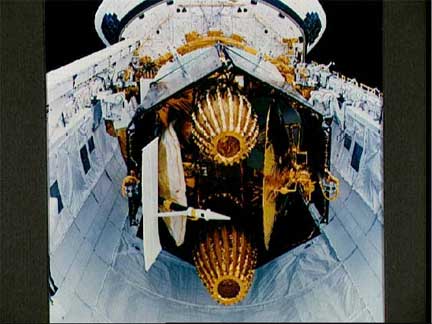
An Artist Rendering of TDRS-4. Credit: NASA
...end-of-mission de-orbit and decommissioning activities. TDRS-4's operational life span was well beyond its original 10-year design. Launched on March 13, 1989, from onboard Space Shuttle Discovery, TDRS-4 operated in geosynchronous (GEO) altitude at more than 22,000 miles above the Atlantic Ocean region. As part of the spacecraft's end-of-mission activities, its orbit was raised above the congested geosynchronous orbit.
TDRS-4 was forced to retire after the loss of one of three Nickel-Cadmium (24 cell) batteries and the reduction in storage capacity for the two remaining batteries that power the satellite. Retirement for the satellite consisted of excess fuel depletion, disconnecting batteries, and powering down the Radio Frequency Transmitters and receivers so that the satellite is completely and permanently passive. This ensures the satellite will never interfere with other satellites from the radio frequency perspective.

TDRS-4 onboard space shuttle Discovery about to deploy during STS-29. Credit: NASA
"The Space Network spacecraft engineering and operations teams worked together very effectively to execute a practically flawless decommissioning of an incredible satellite," says Mike Rackley, SN deputy project manager at NASA's Goddard Space Flight Center, Greenbelt, Maryland. "TDRS-4 made great and important contributions to NASA's human spaceflight and science missions. We will certainly miss her."
NASA has contracted Boeing to build three additional follow-on TDRS spacecraft, replenishing TDRS-1 and TDRS-4, and expanding NASA's communication services. TDRS-K is scheduled for launch in December of this year followed by TDRS-L in 2013 and TDRS-M in 2015. The SN is managed by GSFC and its primary ground communications facility is located at the White Sands Complex in Las Cruses, New Mexico. The Human Exploration and Operations Mission Directorate and the Space Communications and Navigation Program at NASA Headquarters fund NASA's Space Network.

